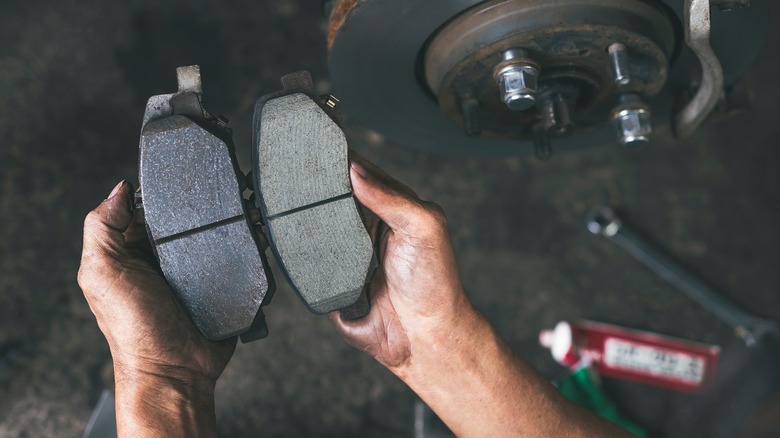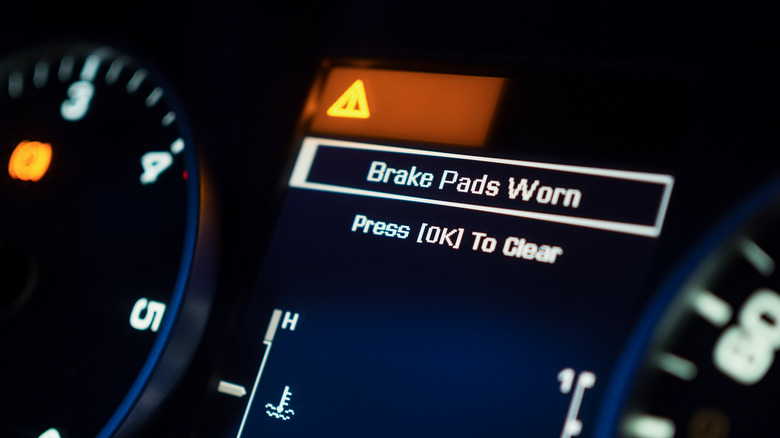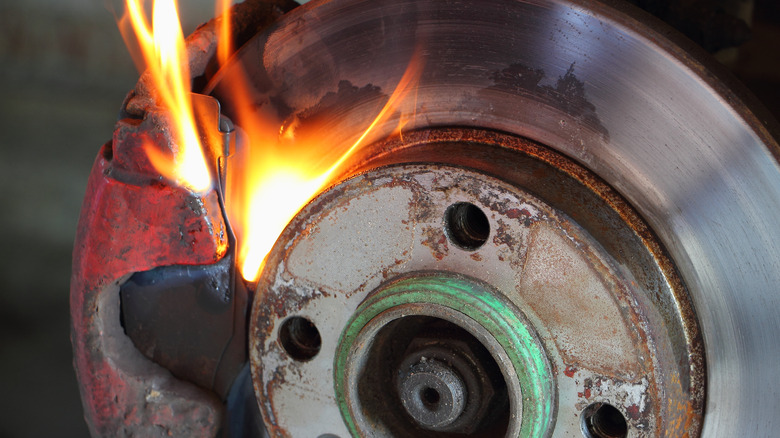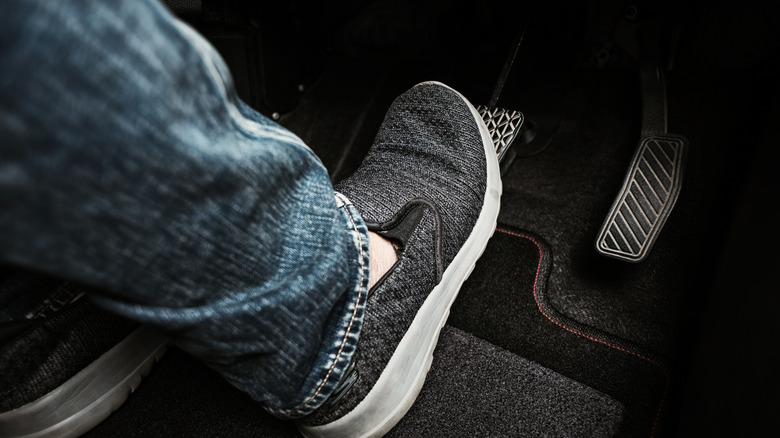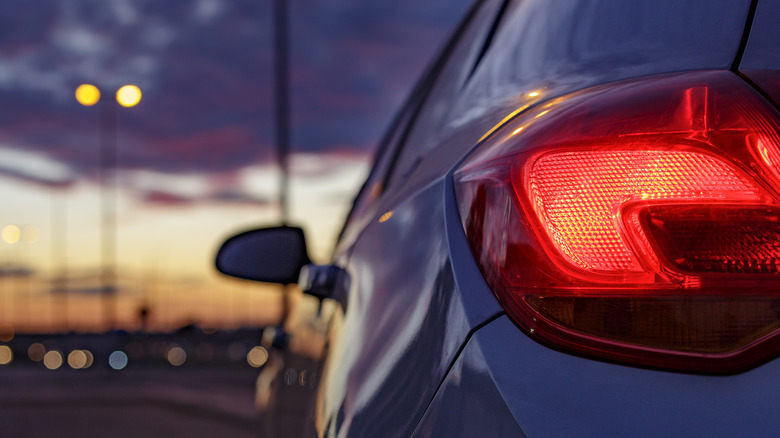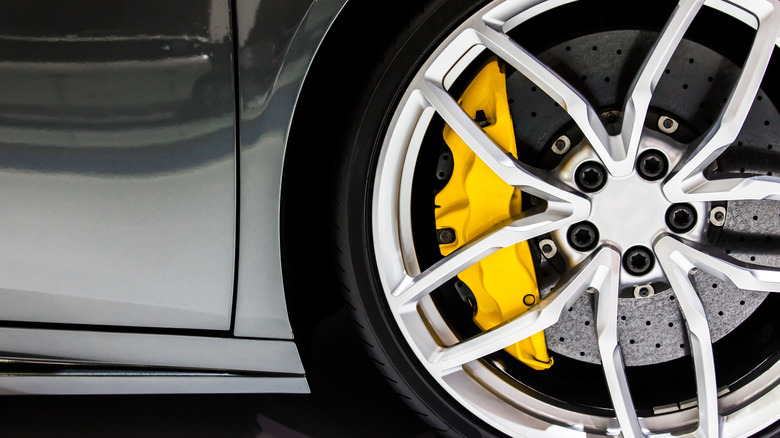5 Signs Your Brake Pads Need To Be Replaced ASAP
Disc brakes are one of the most common braking systems in cars today, appearing in rear-wheel, front-wheel, and all-wheel drive vehicles. When you press down on the brake pedal in the driver's seat, the pressure from the brake line compresses a caliper above your wheel rotor. That caliper is lined with a pair of brake pads, which are made of a high-friction material. These pads are pressed into the sides of your rotor, absorbing its kinetic energy and slowing its spinning. All this results in a smooth braking experience you need for safe driving.
However, while brake pads are designed to absorb large quantities of kinetic energy and safely disperse it as heat, that doesn't mean they're indestructible. Over a car's lifespan, particularly if you regularly subject your braking system to sudden, high-intensity stops, your brake pads can begin to wear out. When those pads wear out, you could swiftly find yourself in a car with little to no stopping power, so be on the lookout for the warning signs and replace them immediately, either on your own or at your local garage, for a fee.
Warning lights
Many modern cars use electronic sensor systems to monitor the efficiency of your brake pads. This is accomplished through special wires that are hooked into the pad and detect when they're getting close to the spinning rotor. In other words, if the brake pad has worn out to a dangerous degree, the wires will get close enough to the rotor to trip a warning signal.
When this warning goes off, the brake pad warning light will activate on your car's dashboard. The exact appearance of the warning light may vary a bit depending on your car's make and model, but generally, it looks like a circle with a pair of dotted lines on both sides of it. When you see that light on your dashboard, that means your brake pads are officially in the danger zone and need to be replaced as soon as possible. Keep in mind that if you have an older car, you may not have these brake warning lights. If this is the case, you may need to watch for other warning signs.
Screeching or grinding sounds
The material your brake pads are lined with is designed to absorb as much kinetic energy from your rotors as possible without damaging them. However, an ordinary metal plate is underneath that material necessary to mount the pads to the caliper. As your brake pads wear out, shaving away the high-friction material, those metal plates may start to come into contact with the rotor. If you've ever been in a metalworks before, you know the piercing noises produced when metal grinds against metal.
If you hear a distinctive screeching or grinding sound whenever you engage your car's brakes, that's the sound of your rotors grinding against the naked brake pad mount. Not only does this sound awful, but it's also a sign that the actual energy-absorbing element of your brakes has already been worn away. Metal grinding against metal won't stop your car as it should, and it's a tell-tale sign to get your brake pads replaced.
Vibrating brake pedal
While your brake pads absorb the energy from your rotors, you aren't supposed to feel anything beyond some slight resistance in the driver's seat. You press down on the brake pedal, slow down, and that's as far as your involvement goes. As your brake pads wear down and lose their effect, you'll start to feel the grinding metal through the brake pedal itself.
When your pads have been worn down, you may feel a distinctive rumbling, vibrating sensation whenever you place your foot on the brake pedal. That's the feeling of your car trying to absorb and dissipate that kinetic energy from the rotors. Without proper brake pads to take the brunt of it, those vibrations are being dispersed throughout the car as the energy tries to escape, and as it so happens, the brake pedal and your foot are convenient avenues. It is possible for your brake pedal to vibrate a bit when driving across rough or uneven terrain, but if it's still rumbling even on a normal road, that's a bad sign.
Reduced braking efficiency
If you try to engage the brakes on your car with worn-out pads, whatever's left of their high-friction material won't be able to fully absorb the energy from the rotors' rotation. As such, while it is technically possible for worn-out brake pads to stop your car, it will take much longer and be much rougher on the suspension. Even a few extra seconds on your stopping distance could mean the difference between an ordinary stop and a fender-bender.
If you press on the brake pedal and it takes several seconds or longer for the car to slow and stop, accompanied by the other warning signs we've listed, like shaking and grinding noises, that's a surefire sign that your brake pads are on their last legs. Proper driving etiquette demands proper brake response time, so if your brakes aren't working, you're endangering yourself and everyone else on the road.
Visible wearing or damage
Unless you're a professional or hobbyist mechanic, you probably don't pay much mind to the elements of your car that aren't immediately apparent. If you're concerned about the state of your brake pads, though, you can take a closer look at your wheels to check for noticeable signs of damage.
While your car is parked and powered down, take a look at your wheels. If you look closely, you should be able to see the brake pads on the inside of the wheel through the gaps in the rims, possibly with a flashlight if your rims are very thick. A new set of brake pads is usually around 12-millimeter in thickness, gradually wearing down with use. If those pads are noticeably thinner than that, that means they're almost completely worn out. Depending on your car's make and model, your brake pads may also have a little slot in the center that serves as an analog warning signal. If you can see that little slot, the brake pads are on their way out.
